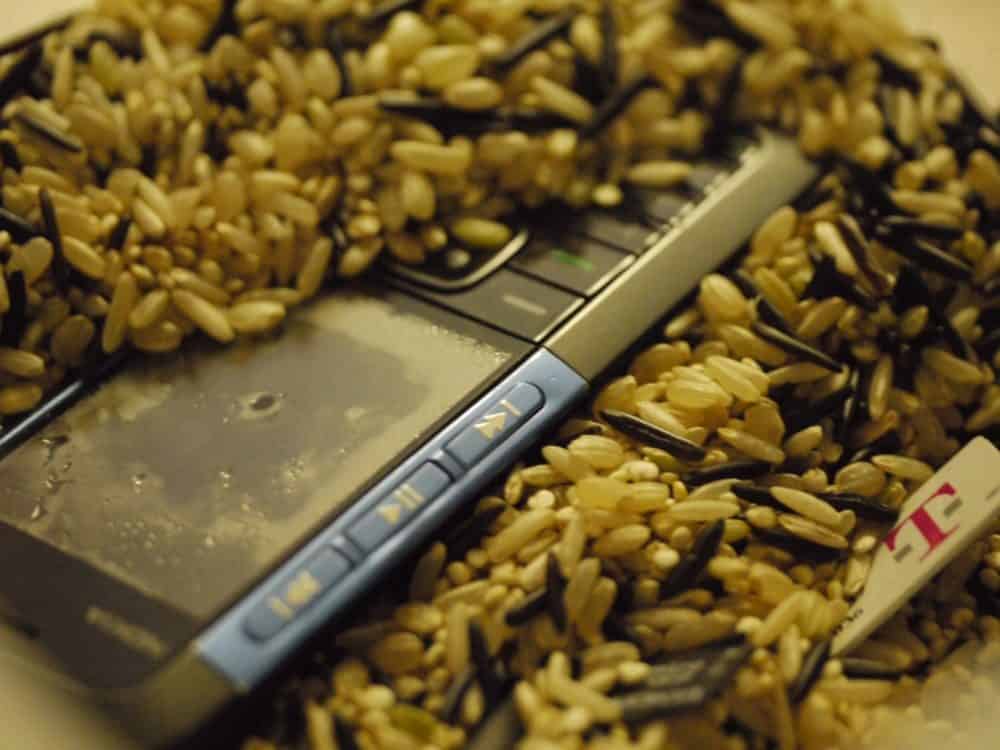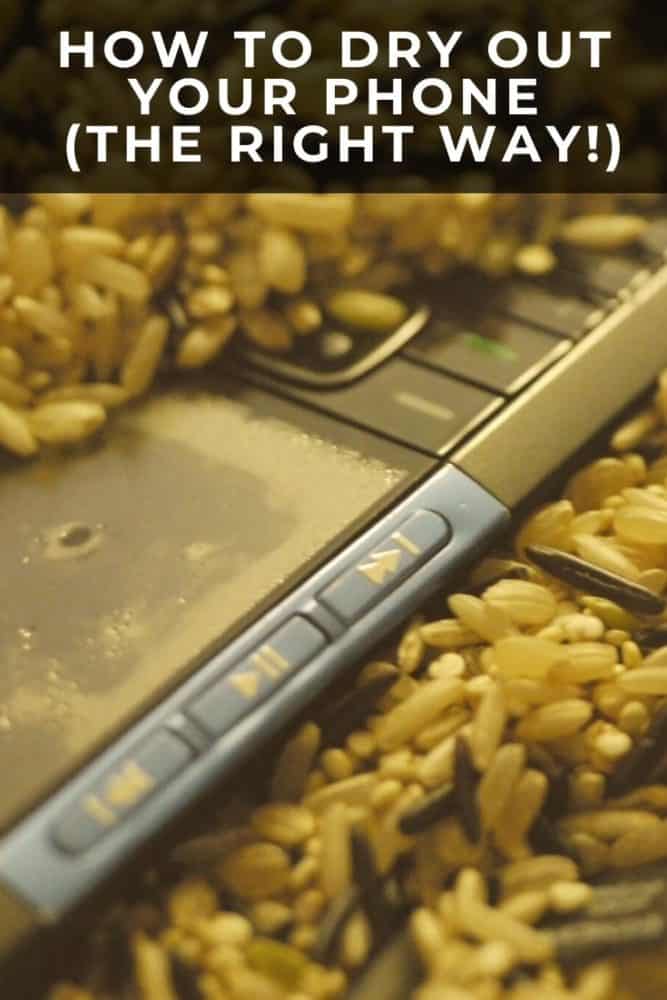How To Get Water Out Of Your Phone Without Rice
It can happen in a moment. Whether your "waterproof" case leaks, an unexpected thunderstorm shows up, or you simply get a bit clumsy in the bathroom after a couple of margaritas, it's way too easy to end up with a soaked smartphone.
We'll all been there. I've personally managed to drown two smartphones in recent years: one in a tulip field in the Netherlands when the heavens opened, and one on a plane when I knocked a glass of water all over myself… and all over my phone.
This is one situation where a little knowledge and preparation goes a long way, whether you're in your kitchen or traveling thousands of miles from home. These tips won't save every phone, but if you're lucky, they might just save yours.
Here's what you need to know.
- 1. Get Your Phone out of the Water
- 2. Turn It off and Start Removing Things
- 3. Dry It With a Lint-Free Towel
- 4. Find Things to Help Dry Your Phone Out
- 4.1. Option A: The "Emergency Kit" Method
- 4.2. Option B: The Old "Smartphone in Rice" Method
- 4.3. Option C: The "Air it Out" Method
- 5. How to Get Water Out of Your Phone Speaker
- 6. The Moment of Truth
Get Your Phone out of the Water
Simple, right?Eww, but I dropped it in the toilet!I need to get some rubber gloves on… No. Tough it out. Every second of water exposure reduces the phone's chances of making it out alive.Wash your hands thoroughly later, but for now, the priority is to get your phone away from any more water.
If it's raining, wrap it in any material that won't let in more liquid: a plastic bag works in a pinch. And, obviously, get your phone (and yourself!) out of the rain as soon as you can.
Turn It off and Start Removing Things
The case, and any other accessories, need to get out of the way ASAP. Much like in the emergency room when your clothes get cut off instead of carefully removed, seconds matter.
If it was plugged in when water was spilled on it, carefully turn it off at the wall and remove the plug from the socket. Water and electricity don't mix.
If the phone didn't shut down automatically, power it off now. For those with an iPhone, you're limited in what you can remove: it's pretty much just the SIM card if you're using one. With Android devices, you may also have a microSD card that can come out, and with a few models, the battery as well.
Basically, anything that can be removed, should be. The more you can open up the phone, the less water will get trapped inside. All of the components mentioned above can also be damaged by water themselves, so taking them out and drying them off just makes sense.
Dry It With a Lint-Free Towel
It's time to coddle this piece of tech you've just abused. If you wear glasses or own a DSLR, you probably have a lint-free towel laying around. If you don't, a paper towel or washcloth will have to do.
Get rid of as much water as you can. The front and back of the phone should be completely dry by the time you finish. Be sure to get the cloth into the charging port, headphone jack, SIM slot, and any other nooks and crannies you can find.
The more water you can remove yourself, the better. Take your time with this: it's important.
Find Things to Help Dry Your Phone Out
Now you've got rid of the surface water, it's time to do what you can about the liquid inside your phone. I've listed three options here, depending on how well you've planned and where you are when disaster strikes.
Note that whatever approach you take, don't try to use high heat to speed up the process. You'll damage your phone even more if you sit it on top of the radiator for hours, or try to blast hot air through it with a hairdryer or fan heater.
Option A: The "Emergency Kit" Method
There are a few premade kit options on Amazon, including this Nine Lives version. They all work in a similar way: you put your phone inside, seal the top, leave it for at least 24 hours, and fervently pray to any nearby gods.
The kits use desiccants to absorb moisture and reduce humidity. You know those little bags in food and electronics packaging that say 'DO NOT EAT'? It's the same stuff.
Keeping one of these kits at the back of a cupboard could end up saving you hundreds of dollars on a new phone, but if you're traveling, bear in mind you're unlikely to easily find this sort of thing while backpacking across Asia.
If you're hitting the road, do yourself a favor and pick one up before you go. Think of it as a first-aid kit for your tech if you need to justify the minuscule extra weight in your bag.
Sadly you can't cheat by using those little bags of desiccants you've been collecting from your Amazon boxes. Those water-absorbing beads are a one-shot deal: once they've been used, they're basically worthless. Although it's theoretically possible to reactivate them by baking them in a low-temperature oven for a couple of hours, you need a lot of them and it's unlikely to be worth the effort.
These kits are by far the best way of drying out your phone, but of course, it relies on you having been prepared enough to buy one in advance. If you didn't, then read on.
Option B: The Old "Smartphone in Rice" Method

Putting your phone into a bowl of uncooked rice is a well-known way of trying to dry it out. It's not ideal, but if you're traveling or otherwise don't have access to the emergency kit mentioned above, it's certainly better than doing nothing.
That said, a few small details make a big difference in how well this approach will work.
- Ensure your phone is powered off, taken apart as much as possible, and completely dry on the outside and in the charging port.
- If you have a container with a lid, use it. Fill it with enough uncooked rice to completely surround the phone on all sides, then put the lid on.
- If you've removed the battery or other components, put them in the rice as well.
- Put the rice and phone under a desk lamp or similar mild heat source to encourage the evaporation process.
- Give it as long as you can. Ideally you want to give it 48 hours or more, but at least leave it overnight if you can. While some phones won't be revived no matter how long they sit in rice, the longer the better.
- Before reassembling, check carefully to ensure no grains of rice remain inside the phone. Check headphone sockets and charging ports in particular. A wooden or plastic toothpick is the easiest and most available tool: don't use metal if you can possibly avoid it, since it can damage the electrical contacts.
Option C: The "Air it Out" Method
Let's say the grocery store is closed or you're in the middle of nowhere, and even a bag of rice is impossible to come by. What then?
Look around the area for a place with air movement. Hopefully you're indoors by now, or in some other place where there's little chance of the phone getting wetter. Your main goal at this point is evaporation of whatever liquid is still inside.
A fan is ideal, but even a laptop, cable box, or TV has some exhaust vents. You don't really want dirty air blowing onto your phone, so give the fan blades or air vents a quick wipe to remove any obvious dust and dirt.
Be sure the phone rests at an angle, with the charging port or SIM card slot pointing downward: water should be flowing out of the device, not pooling inside of it. Put a paper towel or napkin underneath to absorb whatever water drains out.
The longer it can air out, the better. Again, at least give it overnight, with a day or two much better if you can.
Get Us in Your Inbox
Get our regular email updates with the latest travel tech news, tips, and articles. We'll also send over our free 25-page guide, packed with useful hints and advice to get you started! No spam ever, and you can leave any time. Our privacy policy explains how we handle your personal information.
Thanks!
Please check your email for a message from us. You'll need to click the button in that email to confirm your details.
How to Get Water Out of Your Phone Speaker
Even if you have a water-resistant phone (but especially if you don't), getting water in the speakers can be a real problem, particularly when it stays there for a long time. You'll end up with muffled, distorted, or crackling sound at a minimum, and permanent damage to your speakers at worst.
Fortunately, there's a surprisingly easy fix for this. After you've done the usual care tips mentioned above, like drying everything with a lint-free cloth, it's time to head to the app store. Obviously this only applies when your phone is otherwise working properly: it's not going to solve other kinds of water damage!
The approach is taken from the Apple Watch, which has an inbuilt way of quickly vibrating the speaker to literally shake the water off. Most smartphones don't have the same feature, but never fear, there's an app for that!
For iPhones, grab Sonic V from the App store. Android users, go for Sonic Sound Wave Generator instead. If you'd prefer not to use an app, websites like Fix My Speakers do much the same thing.
Whichever option you go for, the approach is much the same. These tools work by playing a loud, high-frequency sound that makes the speakers vibrate fast enough to disperse water that's sitting on them.
Simply place your phone on a flat surface, or ideally angled slightly downward, set your volume to maximum, and activate the app or website for a few seconds. With any luck, you'll see small water droplets coming out of the speaker grill, and end up with crystal-clear sound once more.
The usual caveats apply here: there are no guarantees with a method like this, and even a risk of (further) damaging your speakers. Use at your own risk!
The Moment of Truth
One of the biggest predictors of whether a phone will survive being soaked in water is how long you can dry it out for before trying to power it back up again. I mentioned it earlier but will say it again here: keep it turned off as long as possible. At least 24 hours is the minimum, and try for 48 hours or more if you can.
Don't hit the power button to "test it out" or "see if it's fixed yet" before that time. If there's still water inside, it can easily conduct electricity to places on the circuit board that it's not meant to go. The end result? A dead phone that could have been saved if you'd waited a while longer.
Once you've finally run out of time or patience, though, it's time to see if you still have a working phone. Reassemble it, cross your fingers, and try to turn it on.
If it doesn't work, don't despair quite yet: it's possible that the battery short-circuited and drained when it got wet. If your device has wireless charging, make sure the back of the phone is completely dry, then put it on the wireless charger for an hour and try again. Wireless power is safer than wired at this point.
If you can't charge wirelessly, then make sure there's absolutely no moisture in the USB or Lightning socket, charge the phone from the cable for a few minutes, and see how you go.
If you do see signs of life, go through a quick set of tests. Does the touchscreen or keypad work properly? Can you access Wi-Fi and get cell service? Does the screen look normal, with no flickering, lines, or discoloration? If so, breathe a big sigh of relief: you may well have just dodged a bullet.
I'll note that these tactics can also work for tablets and laptops, though laptops are generally far less likely to survive more than a few drops of water. While phones and tablets only have a few places for water to flow in freely, a laptop is basically a glorified sieve.
If you still have a dead phone at this point, sadly it's likely to be time for a trip to the nearest repair shop. Depending on which components got damaged and what kind of phone you have, though, repairs aren't always prohibitive.
After drowning my phone in that tulip field I mentioned earlier, I dried it out under the fan in my hotel room for a day. It came back to life, but kept powering off by itself every few minutes afterward. After tracking down a tiny phone store in Amsterdam, I managed to get it fixed for under 50 euros, including the cost of a new battery.
Your mileage will, of course, vary wildly. iPhones are typically more expensive to repair than other models, especially if you take them to an official Apple store.
If it's too expensive to fix and you find yourself unexpectedly in the market for a new phone, a piece of advice: get one with good water resistance built-in! Look for an IP67 rating or better: this means it will handle being dropped in the toilet or caught in a thunderstorm much better the next time around.
Photo credit: Shutterstock (wet phone) , Mark Ou (phone in rice)

Dave Dean
Facebook Twitter
Founder and editor of Too Many Adapters, Dave has been a traveler for 25 years, and a geek for even longer. When he's not playing with the latest tech toy or working out how to keep his phone charged for just a few more minutes, he can probably be found sitting in a broken-down bus in some obscure corner of the planet.

How To Get Water Out Of Your Phone Without Rice
Source: https://toomanyadapters.com/dry-smartphone-right-way/
Posted by: eaglewelinigh.blogspot.com

0 Response to "How To Get Water Out Of Your Phone Without Rice"
Post a Comment